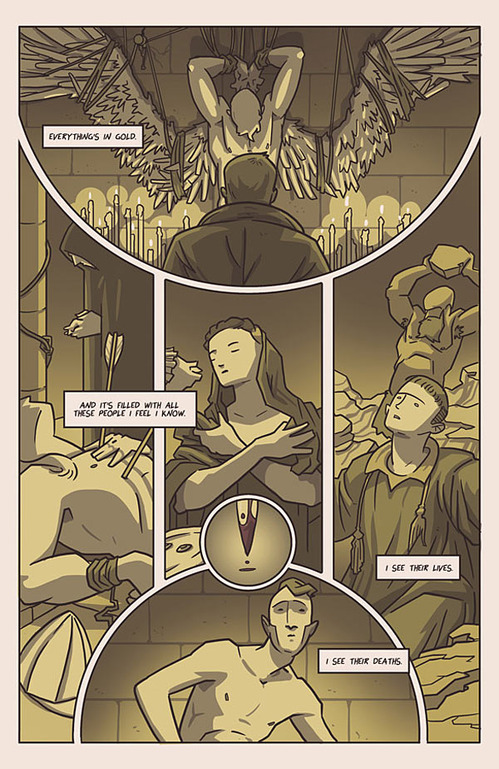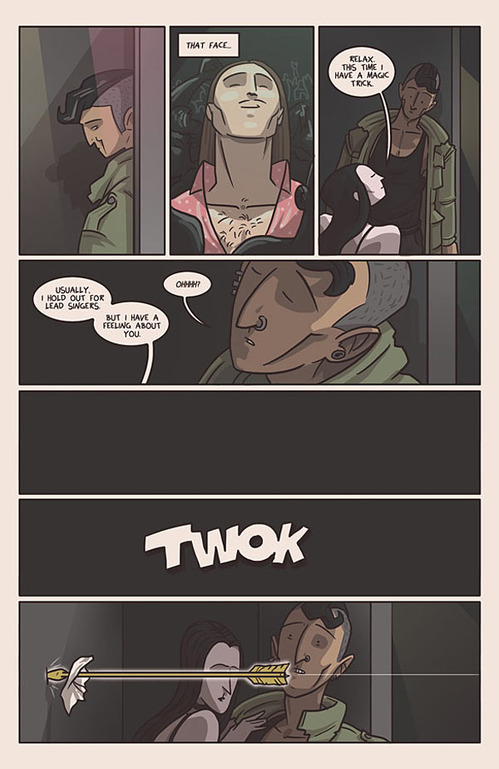Why Aren’t You Reading Sean Lewis & Benjamin Mackey’s Saints?
Saints Art by Benjamin Mackey Comics Features
When we first recommended Sean Lewis and Benjamin Mackey’s Saints, we called the Image sleeper an “an enticing mix of Preacher and WicDiv,” a comparison we feel comfortable reiterating now that the book is more than halfway through its run (solicited as an ongoing, the book has been re-positioned as a nine-issue maxi-series). Lewis, a playwright, and Mackey, who originated the concept, are working in the same Christianity-inspired slum-Americana wheelhouse as Garth Ennis and Steve Dillon’s Vertigo classic, and the pitch of martyrs returning in the bodies of contemporary young people bears more than a passing resemblance to Kieron Gillen and Jamie McKelvie’s reincarnated pantheons. Saints’ protagonists are no rock stars, though: the closest example is main character Blaise Ramirez, the 31-year-old non-starter groupie to a noxious death-metal band. Blaise’s saintly skill lets him “lay hands” on the lead singer’s scream-addled throat to repair shredded vocal chords.
Blaise’s power is very specific, but his fellow saints find themselves blessed/cursed with more widely applicable abilities: flamboyant self-harmer Sebastian is an archer with angel-kissed aim; Lucy, raised by fundamentalists who readily accept and celebrate her sainthood, can show you your past and future; and latest recruit Stephen can telekinetically hurl boulders. The saints of Saints aren’t just Christian reincarnations, they’re practically superheroes. The fifth issue even had a back-up featuring “Sebastian’s original team”—more famous saints with more useful powers.
Described by publisher Image as a “horror/crime” book, Saints instead hits a similar beat as Black Mask breakout We Can Never Go Home: what if mutants who badly needed a Charles Xavier figure suddenly appeared in a world with no School for Gifted Youngsters? Instead of fleeing into the arms of a trusted mentor, the saints find themselves following the advice of a talking Jesus portrait and holing up in the house of a genuinely satanic black metal bro, where they pick up a demon dog. That’s not the kind of guidance doomed youth need in a godforsaken world.
Blaise, Sebastian, Lucy and Stephen aren’t the only saints popping up, either—they’re just the survivors. Hunting down these chosen ones is Michael, a disenchanted former servant of God intent on making sure the saints never fulfill His Will. Like a television super-preacher, Michael has assembled a willing doomsday flock (which doesn’t seem far-fetched in today’s political climate) and a personal Legion of Doom comprised of self-interested religious zealots covering different sects of Christian extremism. By torturing his former ally, Gabriel, Michael has discovered and slain hundreds of saints, and it seems only these four misfits elude his grasp.
In these scenes of mutilation and confinement, Saints does edge toward the “horror” label, but Mackey’s art anchors the book in dark humor and absurdity. His bold lines, geometric faces and lack of superfluous detail brings to mind Gene Luen Yang’s work, with just a hint of the Hernandez Bros’ punk edge. Mackey doesn’t waste a single line, trusting just a few digital brush strokes to convey each expression of anguish, passion or exasperation. It’s easy to imagine Saints in the hands of a more traditional horror disciple, but Mackey’s stained-glass evocations set the book favorably far afield from the heaps of angels-versus-demons comics cluttering shelves over the past decade. A poor man’s Hellboy this is not.
Lewis, who comes to the sequential-art realm from Ira Glass’ breakout podcast, This American Life, gives a Gregg Araki-like off-the-rails atmosphere to the casts’ characterization, introducing us to Blaise as he receives a backstage blowjob and making sure we know virginal Lucy isn’t afraid to kill. Everyone in the world of Saints is a bit unhinged—as you might expect from atheists who suddenly find themselves in the middle of a holy war. Instead of hiding messy secrets, the saints pour their problems out readily, desperately hoping for something, anything that will help explain how and why they’re suddenly racing for their lives across state lines with a bug-like demon clinging to the hood of their getaway car.
Saints is a book that’s going to hit hardest with lapsed Christians who can’t find it in themselves to fully condemn their former faith. Lewis and Mackey mine Catholicism for its coolest “superheroes” while laying bare the selfish goals of modern Christianity’s worst permutations. Rendered in Mackey’s deceptively simple style, the golden visions of Saints don’t feel far removed from Catechism-school day dreams: stained-glass depictions of old white dudes and pure women cavort alongside the metal-inspired doodles you kept hidden in your notebook. Saints is fairly faithful (no pun intended) and referential of its subject matter, while also featuring bands with names like “Sodomite Discharge” and “Mutilated Corpse.” Remaining issues promise a full-on Book of Revelations showdown with Satan’s hell-beasts and the Four Churches of the Apocalypse. It’s a comic as conflicted as most modern Jesus campers, and the guilty pleasure of its remaining issues should inspire some good tortured confessions—and help ensure that Mackey and Lewis get the opportunity to weave more wicked hymns together in the future.


